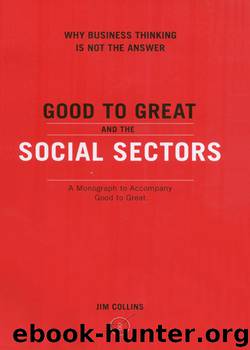Good To Great And The Social Sectors by Jim Collins

Author:Jim Collins [Collins, Jim]
Language: eng
Format: epub
ISBN: 9780062119094
Publisher: HarperCollins
Published: 2005-05-04T16:00:00+00:00
The same idea does not translate to the social sectors. For one thing, as Tom Tierney of The Bridgespan Group aptly observed, the social sectors do not have rational capital markets that channel resources to those who deliver the best results. For another, there is no one underlying economic driver—the analogy to profit per “x”—that applies across all social sector organizations. The whole purpose of the social sectors is to meet social objectives, human needs, and national priorities that cannot be priced at a profit.
We examined the economic components of 44 nonbusiness organizations, across a range of arenas. Using budget statements, annual reports, financial statements, and IRS Form 990s, Michael Lane on my research team collated the information into sources of funds, expense categories, restricted versus unrestricted assets, and executive compensation. While our analysis was limited in scope and modest in ambition, we nonetheless found the data illuminating.
If you place social sector entities in a two-by-two matrix, with one axis representing charitable donations and private grants and the other axis representing business revenue (fee for service, contracts, products, etc.), we find social sector organizations spread widely across all four quadrants. (See “Economic Engine in the Social Sectors: 4 Quadrants”.) Even institutions in the same “industry” can fall into different economic quadrants. Girl Scouts councils, for instance, derive substantial cash flow from selling Girl Scout Cookies®, and almost none from government support13; the Boys & Girls Clubs of America, in contrast, derives more than half its revenue from government support. Furthermore, each economic quadrant demands its own unique skills. Those that rely on government funding must employ political skill and cultivate public support; NASA, for instance, must convince Congress that it merits a budget that would place it high on the list of Fortune 500 corporations. Those that rely on charitable donations, on the other hand, must develop fundraising mechanisms and build emotional connection—“helping to cure cancer will make you feel good”—whereas those that rely heavily on business revenues, such as hospitals, more closely resemble the economic dynamics of a business corporation.
Yet the wide variation in economic structures in the social sectors increases the importance of the hedgehog principle—the inherent complexity requires deeper, more penetrating insight and rigorous clarity than in your average business entity. You begin with passion, then you refine passion with a rigorous assessment of what you can best contribute to the communities you touch. Then you create a way to tie your resource engine directly to the other two circles.
ECONOMIC ENGINE IN THE SOCIAL SECTORS: 4 QUADRANTS
Download
This site does not store any files on its server. We only index and link to content provided by other sites. Please contact the content providers to delete copyright contents if any and email us, we'll remove relevant links or contents immediately.
Hit Refresh by Satya Nadella(8338)
The Compound Effect by Darren Hardy(7561)
Change Your Questions, Change Your Life by Marilee Adams(6641)
Nudge - Improving Decisions about Health, Wealth, and Happiness by Thaler Sunstein(6633)
The Black Swan by Nassim Nicholas Taleb(6192)
Daring Greatly by Brene Brown(5643)
Deep Work by Cal Newport(5468)
Principles: Life and Work by Ray Dalio(5322)
Rich Dad Poor Dad by Robert T. Kiyosaki(5150)
The Myth of the Strong Leader by Archie Brown(4789)
Man-made Catastrophes and Risk Information Concealment by Dmitry Chernov & Didier Sornette(4738)
Big Magic: Creative Living Beyond Fear by Elizabeth Gilbert(4723)
The Slight Edge by Jeff Olson(4722)
Discipline Equals Freedom by Jocko Willink(4638)
Digital Minimalism by Cal Newport;(4545)
The Motivation Myth by Jeff Haden(4528)
Stone's Rules by Roger Stone(4416)
Management Strategies for the Cloud Revolution: How Cloud Computing Is Transforming Business and Why You Can't Afford to Be Left Behind by Charles Babcock(4131)
The Doodle Revolution by Sunni Brown(4043)
